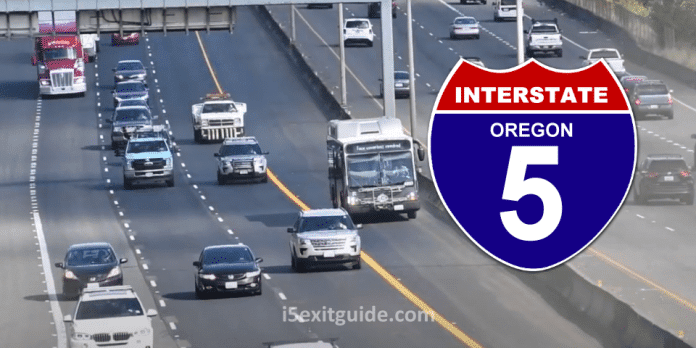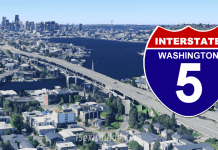Buses will start showing up on the shoulders of Interstate 5 Monday morning as the Oregon Department of Transportation and South Metro Area Regional Transit launch the “Bus on Shoulder” pilot project to help ease congestion and provide more reliable transportation options to the public.
The Bus on Shoulder project will allow SMART buses to use segments of the shoulders along two miles of I-5 between I-205/I-5 interchange and Southwest Elligsen Road when traffic drops below 35 mph.
Last year, ODOT partnered with the Washington Department of Transportation and C-TRAN to implement a Bus on Shoulder pilot project between Oregon and Washington on I-205 across the Glenn Jackson Bridge. The project launched during the September 2020 closure of the northbound span of the Interstate Bridge for the trunnion replacement. Bus on shoulder operations continue on I-205.
Both Bus on Shoulder pilot projects are included in ODOT’s Strategic Action Plan as important outcomes to reduce congestion in the Portland region. The pilot projects are also part of ODOT’s Urban Mobility Office (UMO) Comprehensive Congestion Management & Mobility Plan.
Here’s how Bus on Shoulder works:
- SMART buses may use the I-5 shoulder when the adjacent lane of traffic drops below 35 mph; shoulder use is at the discretion of the bus operator. Weather and other factors can influence the operator’s decision.
- Buses may travel no more than 15 mph faster than the general purpose lanes up to a maximum of 35 mph.
- Buses merge into travel lanes at the conclusion of the bus on shoulder segment; buses will not travel through any on- or off-ramps during the pilot or lane surf.
- If a bus encounters an obstruction in the shoulder, the bus must merge back into travel lanes at least 1,000 feet before the obstruction or as soon as the obstruction is visible
- Cars, trucks and all other non-emergency vehicles must remain on the highway travel lanes and stay off the shoulder except in the case of an emergency or to avoid debris.
- Emergency and law enforcement vehicles, maintenance vehicles, and disabled vehicles take priority on the shoulder.
- Pedestrians and bicycles on the shoulder have priority over buses as well. Transit vehicles are required to merge back into the travel lanes when encountering a pedestrian or bicycle.
New highway signs, pavement striping, and roadway legends will be seen Monday informing motorists of appropriate shoulder uses.
SMART is the only transit provider authorized to use the shoulder in this pilot project. SMART drivers and dispatchers undergo training to ensure safe travel in the corridor. SMART’s bus line 2X operates on I-5, running north and south between the Wilsonville Transit Center and the Tualatin Park and Ride.
In other states, Bus on Shoulder projects have been effective in getting transit vehicles through congestion quickly and safely, creating a more efficient traffic flow, and a more reliable commute. Bus on Shoulder is widely considered a multimodal, low-cost alternative to expanding roadways or dedicating lanes for high occupancy vehicles.
ODOT will closely monitor the pilot project performance. If we find it effective and safe, ODOT may consider making it permanent and consider expanding its use to other transit agencies.
On the road? Why not take us with you. All our websites are mobile-friendly. Visit our growing family of exit guides: I-4 Exit Guide, I-5 Exit Guide, I-10 Exit Guide, I-75 Exit Guide, and I-95 Exit Guide. Detailed exit service listings… discount lodging, camping, food, gas and more for every exit along the way!




